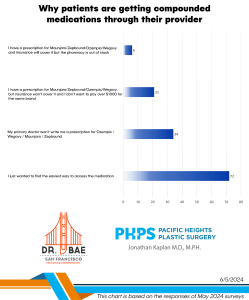First, some basics… and you’re welcome to watch our recent virtual shared consultation it you prefer video! UPDATE TO VIDEO: Guaranteed access to medications is no longer available with the 6-month coaching program if you signed up after midnight as Sunday night, June 4th turned Monday early morning, June 5th. If you read otherwise on this website, this disclaimer here takes precedence.
Incretin mimetics
Ozempic, Wegovy and Mounjaro are all part of the same class of drugs that have been available for human use for over 20 years – incretin mimetics. These drugs mimic the effects of naturally occurring gastrointestinal hormones like glucagon-like peptide (GLP-1) and gastric inhibitory peptide (GIP).
What do these naturally occurring hormones do in the body? They suppress your appetite after eating so you feel full and they stimulate the pancreas to produce insulin, which shifts sugar from the blood stream into the tissues for use as energy.
As the class name suggests, these drugs ‘mimic’ the effects of these hormones. For example, Ozempic and Wegovy stimulate the same receptors that glucagon-like peptide (GLP-1) stimulates in the body to suppress appetite, slow gastric emptying (food moves more slowing from the stomach to the intestine so you feel more full and eat less) and release insulin from the pancreas.
The Twincretin!
Mounjaro acts by mimicking two hormones, in other words it’s a “twincretin!” It acts on the GLP-1 receptors like Ozempic and Wegovy but also acts on the same receptors that GIP acts on, stimulating the gastric inhibitory peptide effects, further suppressing appetite.
Type 2 Diabetes Treatment
As you might have guessed (or not), Ozempic and Mounjaro, by acting on the pancreas to produce insulin, were first approved for the treatment of type 2 diabetes, the version of diabetes that’s most associated with obesity. [Type 1 diabetes is very different from type 2 diabetes. In type 1 diabetes, there’s a genetic or autoimmune reason for the insulin-producing cells in the pancreas to no longer produce any insulin. In this case, type 1 diabetics need insulin injections to live. This is very different from the cause of type 2 diabetes and how its treatment.] Leading up to obesity, people eat more food than their body needs, and that high sugar/carbohydrate diet is converted to and stored as fat, resulting in obesity.
And each time they eat, their pancreas is stimulated to produce insulin. After many insulin spikes over years of overeating, the pancreas becomes “burned out” and doesn’t produce enough insulin. So sugar in the blood isn’t shifted into the tissues for energy, leading to the body’s inability to get enough energy for critical functions like ensuring the brain and other organs work properly.
Weight Loss Approval
These medications were originally approved by the FDA to treat type 2 diabetes by enhancing the seretion of insulin from the pancreas. During the course of the drug approval study process, incretin mimetics were found to produce significant weight loss. So NovoNordisk, the maker of Ozempic, submitted the same active ingredient in Ozempic, semaglutide (an incretin mimetic) for approval as a weight loss drug, ie Wegovy. Therefore Ozempic and Wegovy are the same medication but for different indications/treatments.
Similarly, Mounjaro was approved for type 2 diabetes and was also found to have significant weight loss effects. Eli Lilly, the maker of Mounjaro is currently going through the FDA approval process to get the same active ingredient, tirzepatide, approved for obesity treatment.
Ozempic/Wegovy vs Mounjaro
How do these medications compare? Let’s focus on their weight loss results rather than their effectiveness for treatment of type 2 diabetes.
Both are once per week injections.
Dosages for Ozempic (approved for type 2 diabetes) are 0.25mg, 0.5mg, 1mg, 1.7mg and 2.0mg.
Dosages for Wegovy (approved for obesity) are 0.25mg, 0.5mg, 1mg, 1.7mg, 2.0mg and 2.4mg.
Dosages for Mounjaro (currently only approved for type 2 diabetes but already being used off-label for obesity) are 2.5mg, 5mg, 7.5mg, 10mg, 12.5mg and 15mg.
In the paperwork for the FDA approval of Mounjaro, there’s a helpful table comparing weight loss in Mounjaro and 1mg of semaglutide (the active ingredient in Ozempic and Wegovy) in patients with type 2 diabetes after 40 weeks of treatment.
The patients on semaglutide lost 5.7 kg (12.5 lbs). Patients on a relatively higher dose of Mounjaro (10mg), lost 19.3 kg (20.5 lbs), ie more than those on semaglutide, the active ingredient in Ozempic and Wegovy.
This is one reason many believe that Mounjaro, as a twincretin, will eventually have greater weight loss results than Ozempic/Wegovy. Some are predicting consistent bariatric surgery weight loss without the bariatric surgery when taking Mounjaro (tirzepatide)!
The other data point in Mounjaro’s favor is its safety profile. Whereas Ozempic/Wegovy led to nausea in 44% of patients, three studies show that the risk of nausea with Mounjaro ranges from 12-18%. Keep in mind that with Wegovy, the nausea was only bad enough to force 1.8% of patients to quit. The others found the benefits outweighed the downsides.
Risk vs Benefits
And that’s a common theme with these medications. Each person must weigh the pros and cons for themselves. If you’re morbidly obese and need to lose 100 pounds, you may be willing to accept the risk of nausea, especially when you can take other medication (Zofran) to alleviate those symptoms.
Many often ask about the risk of medullary thyroid cancer seen in some rats during studies with incretin mimetics. Some rats exposed to these medications in the lab developed medullary thyroid cancer but so did some of the rats that were taking a placebo (not the medication) as part of the control group.
Additionally, the FDA has not been able to determine if this is significant in the development of medullary thyroid cancer in humans. The incidence of medullary thyroid cancer in humans has been rare and stable in humans for over 30 years even though this class of medications has been used in humans for over 20 years. So no increased incidence. But if you’re still worried about getting thyroid cancer with these medications, then I would argue that your risk of dying from heart disease and diabetes by not taking these medications is significantly higher than the risk of dying from a rare form of thyroid cancer by taking these medications.
Wanna learn more? Read this post here, here and here. And if you’re ready to schedule a consultation, it’s easiest to pay for the consult here and receive priority scheduling. After the consult and reviewing your labs, you’ll have the choice, semaglutide ($500 per month) vs tirzepatide ($600 per month).




